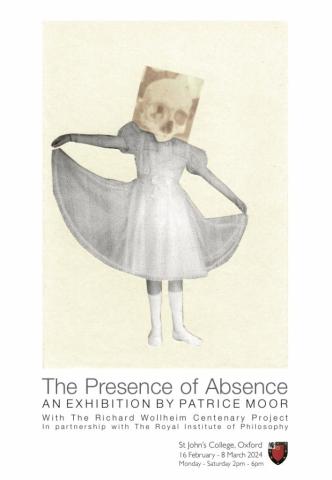Venue, Timing and Cost

Kendrew Barn
Friday 16 February - Friday 8 March
14:00 - 18:00
Closed on Sundays
The exhibition The Presence of Absence comes about from the concurrence of Patrice Moor’s intention to bring her work to an audience attuned to psychoanalytic understanding, and the Richard Wollheim Centenary programme for the academic year 2023-2024, mounted by the Interdisciplinary Psychoanalytic Thought network.
Richard Wollheim (1923-2004) was known as a philosopher for his deep and knowledgeable engagement with both psychoanalysis and art, which made use of artistic images to convey the meaning of his philosophical and psychological claims and conclusions. The enduring presence of the past is the subject of Wollheim’s principal work on psychoanalysis, The Thread of Life, and a constant throughout his philosophy is that this thread depends on the rootedness of the whole human self, individual, social, cultural, in its natural bodily being. The nature of embodiment, as it has come to be called, poses philosophical questions about the body’s role in how a person’s experience of their life as they live it is processed, recorded, recalled, and may, or may not, inform their actions. It is this elusive category of embodied experience that Wollheim is concerned with in his philosophy of psychoanalysis, in which art becomes the ‘royal road’ to the psychology of the non-verbalisable.
The psychical situation of the artist, together with its artistic expression in the multisensorial – visual, tactile and spatial – medium of collage, strongly invite an interdisciplinary conversation between psychoanalysis, on the one hand, and art theory and criticism on the other. It is in this conversation that Wollheim’s very particular philosophy of the person has a unique contribution to make and indeed a defining part to play. The intersection between the psychoanalytic and art-critical strands of his work is a place where at different times art and psychoanalysis can each become interpreter to the other. In bringing together art and psychoanalysis, Wollheim’s work is particularly relevant to Moor’s. Undoubtedly the most original philosophical thinker to engage both with psychoanalysis and with art, his is the method that the artist’s work at once suggests.
Salient in the artist’s work is the loss of her mother at 22 months of age and the work itself is a window onto processes of meaning-making prior to language competency. The collages record, depict, express, present, an internal world: that of a ‘child in the adult’ in timeless engagement with a lost mother. In this engagement is seen expressed an internalisation of maternal loss taking place before and in the absence of a linguistic representation and compounded by a ‘second trauma’, the silence about the lost mother among surrounding adults.
The experience of this world that the collages present is seemingly disconnected from the artist’s later self-knowledge made expressible by linguistic competence. This depiction is of great interest both to philosophy and psychoanalysis. It speaks to psychoanalysis’s concern with interruption of the self by developmental trauma and to the philosophical question of how meaning-making prior to language is made possible, as Wollheim argues, in the early formation of ‘the mind’s image of itself’.
Further Information
St John's College
St Giles,
Oxford
OX1 3JP
01865 277300
